A square is a regular quadrangle (or rhombus) in which all angles are straight and the sides are equal to each other. Like any other regular polygon, square can be calculated perimeter and area. If area square already known then find its sides and then and perimeter not be difficult.
Instruction manual
Area square found by the formula:
S \u003d a
This means that in order to calculate area square, you need to multiply the lengths of its two sides by each other. As a result, if you know area square, then when extracting the root from this value, you can find out the length of the side square.
Example: area square 36 cm to find out the side of the given square, you need to extract the square root of the area value. So the side length of a given square 6 cm
To find perimetera square it is necessary to add the lengths of all its sides. Using a formula, this can be expressed as follows:
P \u003d a + a + a + a.
If you extract the root from the area squareand then add the resulting value 4 times, then you can find perimeter square.
Example: Dan square with areaw 49 cm. Wanted to find him perimeter.
Decision:
First you need to extract the square root square: 49 \u003d 7 cm
Then, calculating the length of the side squarecan be calculated and perimeter: 7 + 7 + 7 + 7 \u003d 28 cm
Answer: perimeter square areaw 49 cm is 28 cm
note
For a square, the following definitions are valid:
A square is a rectangle that has equal sides.
A square is a special kind of rhombus, in which each of the angles is 90 degrees.
Being a regular quadrangle, a circle can be described or inscribed around a square. The radius of a circle inscribed in a square can be found by the formula:
R \u003d t / 2, where t is the side of the square.
If the circle is described around it, then its radius is as follows:
R \u003d (2 * t) / 2
Based on these formulas, we can derive new ones to find the perimeter of the square:
P \u003d 8 * R, where R is the radius of the inscribed circle -
P \u003d 4 * 2 * R, where R is the radius of the circumscribed circle.
The square is a unique geometric figure, because it is absolutely symmetrical, no matter how and where to draw the axis of symmetry.
Attention, only TODAY!
All interesting
A square is a geometric shape consisting of four sides of the same length and four right angles, each of which is 90 °. Determining the area or perimeter of a quadrangle, and any one, is required not only when solving ...
The tasks of calculating the area of \u200b\u200ba particular geometric figure have to be solved by the schoolchild and student, surveyor and architect, cutter and turner. Circle area can be calculated different ways, depending on what data you ...
A square is a regular quadrangle in which all sides are equal and all angles are right. The perimeter of a square is the sum of the lengths of all its sides, and the area is the product of two sides or the square of one side. Based on the known relationships, through ...
A square is one of the simplest flat polygons of regular shape, all angles at the vertices of which are 90 °. Not many parameters that determine the size of a square can be called - this is the length of its side, the length of the diagonal, area, perimeter and ...
The perimeter is the total length of all sides of the geometric figure. Usually it is found by adding the sizes of the sides. In case of regular polygon the perimeter can be found by multiplying the length of the segment between the vertices by the number of such segments. ...
A circle inscribed in a polygon is considered to be a circle that touches all the sides of a given polygon without exception. One type of polygon is a square. How to find the radius of a circle inscribed in a square? You…
Very often, students make queries in a search engine: how to find the volume of a square. There can only be one answer: this is impossible. A square is a two-dimensional figure (two parameters: length and width). To calculate the volume, you must have a third ...
Although the word "perimeter" comes from the Greek designation of a circle, it is customary to name the total length of the borders of any flat geometric figure, including a square. The calculation of this parameter, as a rule, is not difficult and ...
A square is a rectangle with equal parties. This is perhaps the simplest figure in planimetry. Due to the high degree of symmetry of this figure, to calculate the square area, just one of its characteristics is enough. It could be ...
A square is a regular quadrangle or rhombus, in which all sides are equal and form angles of 90 degrees. The diagonal of a square is a segment that connects two opposite corners of a square.
To find…
The perimeter is the total length of the border of the figure most often on the plane. A square is a regular quadrangle or rhombus, in which all angles are straight, or a parallelogram, in which all sides and angles are equal. You will need Knowledge on ...
A square is a beautiful and simple flat geometric figure. This is a rectangle with equal sides. How to find the perimeter of a square if the length of its side is known? Instruction1First of all, it is worth remembering that the perimeter is nothing but the sum ...
Objectives of the study To identify the relationship between the perimeters of the figures and their area. Hypothesis The larger the perimeter, the larger the area of \u200b\u200bthe figure. What you need to find out: What are the properties of the perimeter and area of \u200b\u200bthe figures? How are the perimeters and areas of the rectangles connected? Which figure has the largest area for a given perimeter? What area units are used to measure land?
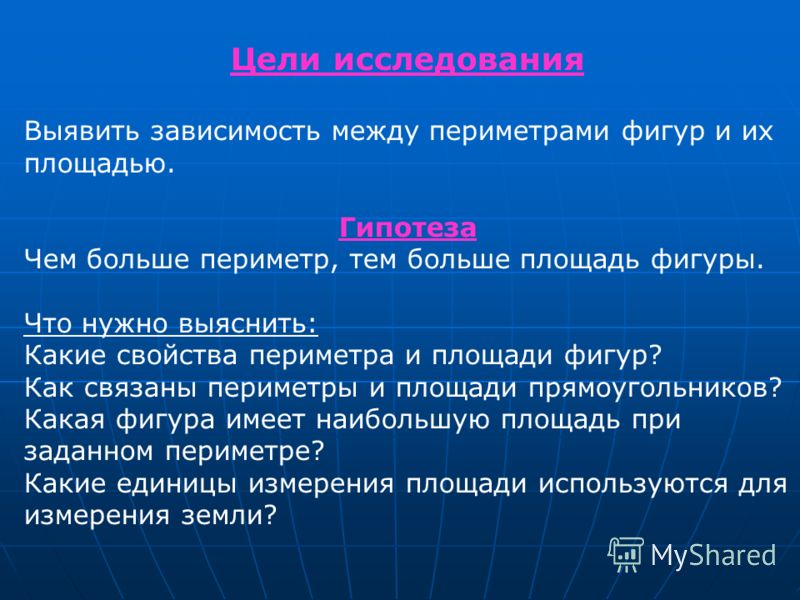
We know: Perimeter - the sum of the lengths of all sides of the polygon. Perimeter - the sum of the lengths of all sides of the polygon. Shape area - a value that shows how much space a figure occupies on a plane. The area of \u200b\u200ba figure is a value showing how much space a figure occupies on a plane. Properties: Properties: 1. Equal figures have equal areas; 2. The area of \u200b\u200bthe whole figure is equal to the sum of the areas of its parts; 3. The area of \u200b\u200ba square with a side equal to a single segment is taken as a unit of area

If one of the figures has a larger perimeter than the second, then its area is larger, smaller or different? We noticed that if the perimeter of one rectangle is larger, then its area is larger than that of others. But if the perimeters are equal, then the areas can be different. What determines the area of \u200b\u200bthe rectangles, if their perimeters are equal? First we look at the rectangles First, we look at the rectangles
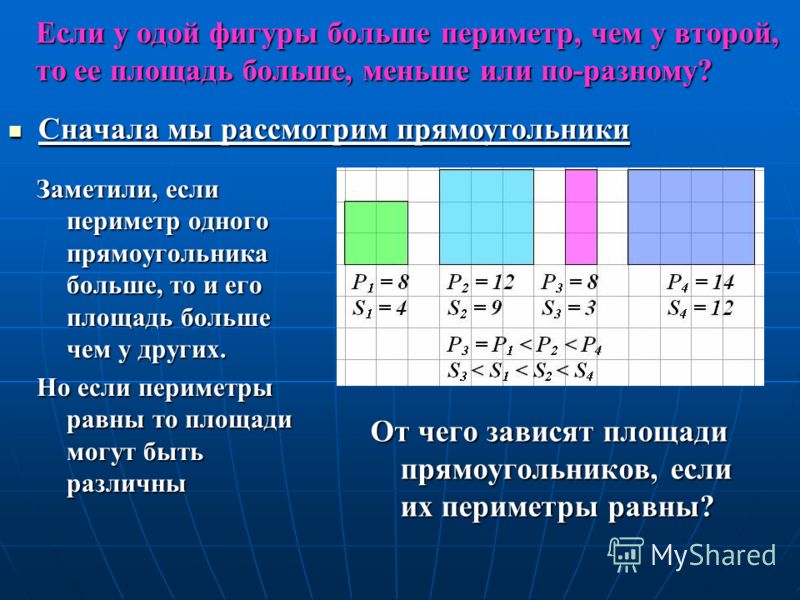
Which of all rectangles of a given perimeter has the largest area? The solution to this problem was known to mathematicians of ancient Greece. It is stated in the book of Euclid, where it is proved that if we consider a rectangle and a square of the same perimeter, then the square will be larger.


How Groin bought land (Leo Tolstoy's task) - “And what price will it be?” Says Groin. - We have one price: 1000 rubles per day. I didn’t understand Groin. - What is the measure - the day? How many tithes will be in it? We, - says, do not know how to count. And we sell per day: how much you get around per day is yours, and the price of the day is 100 rubles ... Whatever circle you want, take it to the place you came from just before sunset. What will go around all yours Which way should Groin choose to get a large area of \u200b\u200bland?
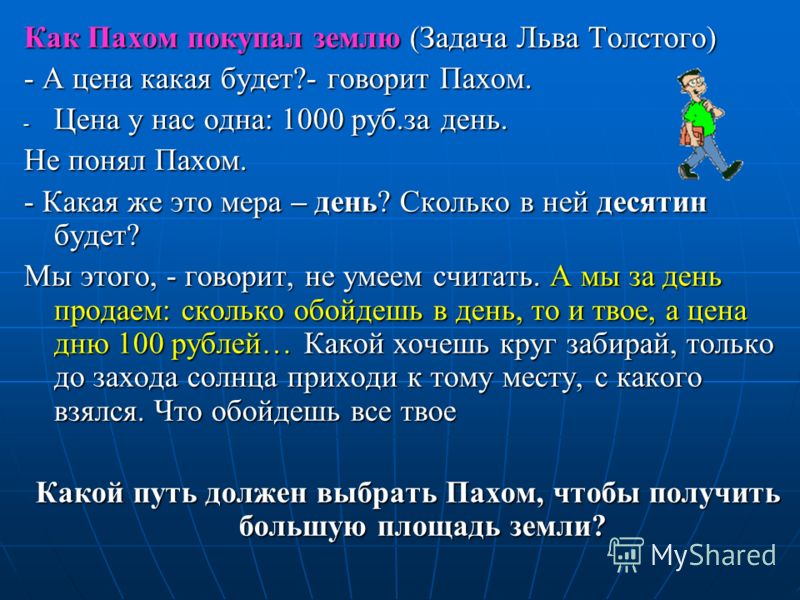

The following units are used to measure land: Metric units of an area of \u200b\u200b100 square meters - a (ar): 100 square meters - a (ar): 1 ar \u003d 100 m2; 1 ar \u003d 100 m2; A square with a side of 100 meters - A square with a side of 100 meters - ha (hectare): 1 ha \u003d m2; 1 ha \u003d m2; Non-metric area units
 Conclusion 1. If the perimeter of one rectangle is larger, then its area is larger than that of others. 2. If the perimeters of the rectangles are equal, then the area may be different. 3. Of all the rectangles with equal perimeters the largest area has a square. 4. For equal-sized figures, the more vertices, the larger the perimeter.
Conclusion 1. If the perimeter of one rectangle is larger, then its area is larger than that of others. 2. If the perimeters of the rectangles are equal, then the area may be different. 3. Of all the rectangles with equal perimeters the largest area has a square. 4. For equal-sized figures, the more vertices, the larger the perimeter.

The study of the area of \u200b\u200bthe rectangle of this perimeter
Mathematics teacher MBOU of the city of Shakhty, Rostov Region "Gymnasium named after A. Pushkin"

annotation
This methodological development It is a description of its author’s experience related to the application of the method of research work with students in mathematics and extracurricular activities in the subject.

Purpose of the study
Identify the relationship between the change in the length of one of the sides of the rectangle and the area at a given perimeter of the rectangle.
Hypothesis
With a change in the length of one of the sides of the rectangle at a given perimeter, the area of \u200b\u200bthis rectangle will also change.
How are the perimeters and areas of the rectangles connected?
Which rectangle has the largest area for a given perimeter?
What you need to find out:
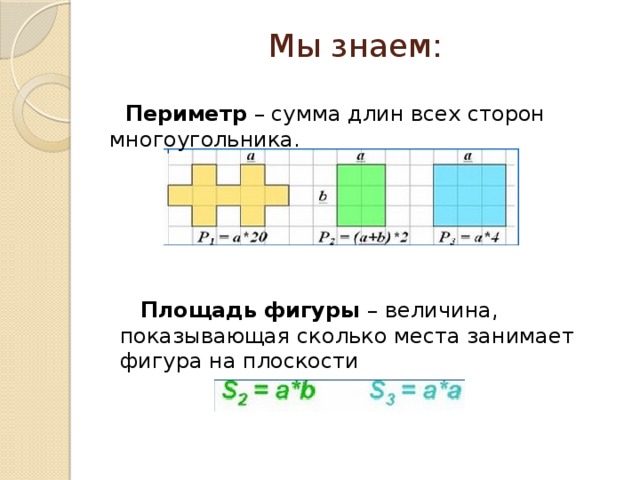
We know:
Perimeter - the sum of the lengths of all sides of the polygon.
The area of \u200b\u200bthe figure - a value showing how much space a figure occupies on a plane

If one figure has a larger perimeter than the second, then its area is larger, smaller or different?
First we look at the rectangles.
We noticed that if the perimeter of one rectangle is larger, then its area is larger than that of others.
But if the perimeters are equal, then the areas can be different.
What determines the area of \u200b\u200bthe rectangles, if their perimeters are equal?

Which of all rectangles of a given perimeter has the largest area?
The solution to this problem was known to mathematicians of ancient Greece. It is set forth in the book of Euclid.
The perimeter of the rectangle is 24 cm, and its base x (cm). Define the dependence of the area S () of the rectangle on x as the formula.

Fill the table:
x (cm) - the base of the rectangle
x cm
At what value of x do you get the rectangle of the largest area? What is the largest S value obtained?
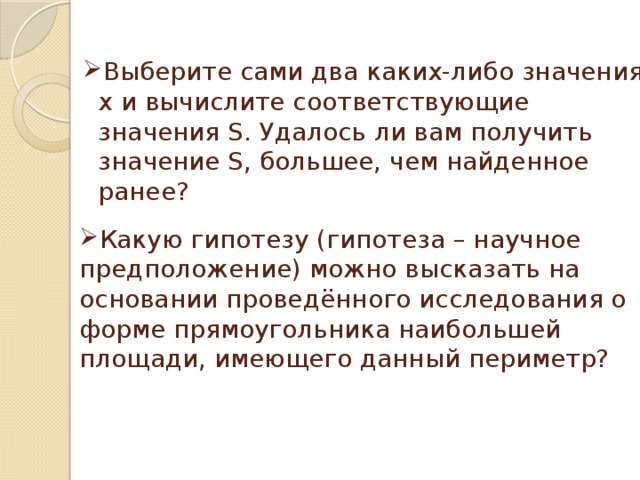
- Choose yourself any two values \u200b\u200bof x and calculate the corresponding values \u200b\u200bof S. Did you manage to get a value of S greater than that found previously?
- What hypothesis (hypothesis is a scientific assumption) can be expressed on the basis of a study on the shape of the rectangle of the largest area having a given perimeter?

1. If the perimeters of the rectangles are equal, then the area may be different.
2. Of all the rectangles with equal perimeters, the square has the largest area.
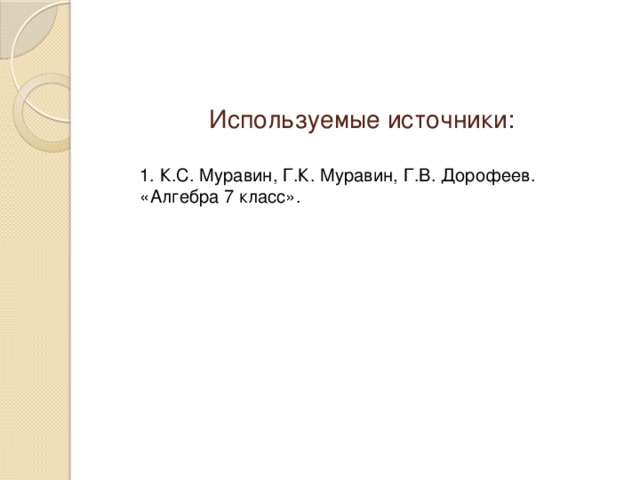
Alekseeva Alina
Objective of the project: establish some dependencies between the area and the perimeter, see their application in a practical situation, confirm or refute the reliability of the famous task about Queen Dido.
Download:
Preview:
REGIONAL OPEN SCIENTIFIC AND PRACTICAL CONFERENCE
“TO THE WORLD OF SEARCH, TO THE WORLD OF CREATIVITY TO THE WORLD OF SCIENCE”
Municipal Autonomous Educational Institution
"Secondary school number 2"
G. Kolpashevo, Tomsk Region
Research
Some dependencies of areas and perimeters.
Alekseeva Alina, grade 6a
Head:
mathematic teacherParfenova Elena Vitalievna
Kolpashevo
2016
Head: Parfenova Elena Vitalievna, teacher of mathematics
Topic “Some dependencies of areas and perimeters”
Educational institutionMAOU secondary school No. 2 of Kolpashev
Media Resources UsedwORD text editor, POWER POINT editor, Internet resources
Objective of the project : establish some dependencies between the area and the perimeter, see their application in a practical situation, confirm or deny the reliability of the famous task about Queen Dido.
Tasks:
Repeat theory on research topic
Carry out the necessary research and experiments
Draw conclusions
Consider the practical application of the results
1) Relevance of the topic
With the concept of perimeter and area, we get to know more primary school. These important concepts are necessary for a person throughout his life. And the point is not only that the activities of representatives of certain professions are inconceivable without solid knowledge on this topic.
(builders, engineers, farmers, seamstresses, etc., it is more difficult to name the sphere of human activity where these concepts are not useful). The concepts of area and perimeter are necessary for a person in the surrounding life constantly, the most commonplace example is to make repairs in a room, apartment, house. Both sides are connected by the sides of polygons; therefore, knowledge of the dependencies between these quantities is very important for modern man
2) Definition of the subject of research
So, let us recall the facts well known to us.
Area - a value characterizing the size of the surface occupied by the geometric figure. (How much space the figure occupies on the plane).
Perimeter - the size of the borders (contour) of the geometric figure. (The sum of the lengths of all sides).
The properties
Equal figures have equal areas.
The area of \u200b\u200bthe whole figure is equal to the sum of the areas of its figures.
For the unit area take the square area, the side of which is equal to a single segment.
3) Wording problem
Despite its importance, I can’t recall any dependencies connecting the areas and perimeters that we would study at school
The simplest example, which leads to a dead end of inexperienced inhabitants
There are two plots of land 60x100 and 50x120m. It seems the area is the same, but the first is more profitable to buy - the fence is 20m shorter to build! Joking as a joke, and from the point of view of mathematics everything is clear, but logically it’s somehow strange, like the perimeter isa closed imaginary thread, but the fact that inside it should not change, no matter how you twist it. Why is there a difference in perimeters? So still, are there any dependencies, or does the area and perimeter in no way depend on each other?
- Hypothesis
We assume that some dependencies exist.
It can even be assumed that if the area is larger, then the perimeter is larger,
the more sides, the more the perimeter.
- Hypothesis test
We begin our research with a simple and well-known rectangle figure.
Study No. 1.
Fill the table, considering the area of \u200b\u200bone cell equal to 1 cm2
In C
Table number 1
Figure | |||||
Area (S) | |||||
Perimeter (P) |
Examining the measurement results, we conclude that not always increasing the area means that the perimeter also increases. With the same perimeter and area are different! Why is this happening?
We continue the observation.
Research No. 2.
Table number 2
Length | Width | Area | Perimeter |
|
Rectangle | ||||
Rectangle | ||||
Rectangle | ||||
Rectangle | ||||
Rectangle | ||||
Rectangle | ||||
Rectangle |
We notice that with equal areas the perimeters are not equal, the smallest perimeter of all rectangles with equal areas in the square.
What a wonderful property the square has! Among all rectangles of the same area, it has the smallest perimeter !!!
Obviously, we can conclude that, with the smallest perimeter, the square has the most favorable area.
Remember this the remarkable property of a square is to enclose the largest area within its borders with a constant perimeter.
Table number 3
Conclusion: It seems that the assumption that the more sides there are, the more the perimeter is confirmed.
- Explanation of Results
Why do such dependencies arise, what is the reason. To better understand this issue, we will conduct an experiment.
Experience.
I took an arbitrary rectangle. Measured its length, width, area and perimeter, the measurement results are listed in table No. 4
(1 line).
Now cut the piece in half and made up a new piece
Table number 4
Length | Width | Area | Perimeter |
|
Before cutting | ||||
After cutting |
-------
| | |
| | |
| | |
-------
----
----
----
The number of squares has not changed. We observe what happens to the sides of the rectangle when the perimeter increases.
The figure appeared additional sides, which became borders, this is an additional 20 cm, and the border 5 + 5 \u003d 10 cm disappeared. Total 20-10 \u003d 10 cm. Here is an additional 10 cm. The perimeter will increase.
7. Key findings.
- So, with the smallest perimeter, the square is the most profitable area.A wonderful property of a square is to enclose the largest area within its borders with a constant perimeter.
- Not always increasing the area means that the perimeter is also increasing. With the same perimeter and area are different!
- The more sides, the more the perimeter is confirmed.
8. Practical tasks.
Task 1 The perimeter of the square was increased by 40, then the perimeter of the resulting square was reduced by 40. Which of the squares has the smallest area
Answer. The larger the perimeter of the square, the larger its area. 40 from the perimeter of the second square is greater than 40 from the perimeter of the first. So, the smallest perimeter, and then the smallest area of \u200b\u200bthe third square.
Task 2 We placed 15 discs as shown in the diagram. The perimeter of each disk is 12 cm. What is the external perimeter of this figure?
Answer. The task is interesting and difficult for me. I did so. She folded all the halves, there are 9 of them, which means the perimeter-54. 3 angular circles remained. If you connect their centers with lines, you get an equilateral triangle. The sum of the angles of a triangle is 180 degrees, (this is half the disk perimeter).
those. 12x3-6 \u003d 20. Since I took 3 circles, then 3 circles remained minus one half, the entire perimeter is 54 + 30-84
Task 3 . The man figured in his mind that he could lay out the floor of a square-shaped room with square tiles, and that he would not need to cut any of them. First, he laid tiles on the edges of the room and it took him 56 tiles.
Find how much he needs to have tiles to cover the entire floor? What is the sum of the digits of this number?
Answer. I subtracted 4 corner tiles from 56, then divided 52 by 4, got tiles in the same row plus 2 corner tiles, it turned out 15, I multiplied by 15, it turned out 225, the sum of the numbers is 9.
Task 4. Draw some small square. How to change its sides in order to build a square whose area would be: 1) four times as much? 2) 9 times more? 3) 16 times more?
Check the solution by building.
Answer:
1) Parties to increase 2 times
2) Parties to increase 3 times
3) Parties to increase 4 times
Task 5. Of the 22 matches, add the rectangle of the largest area. (Do not break the matches!) So - as I know that with a constant perimeter, the largest area is enclosed by a square, but a square will not work, since 22 is not divisible by 4. and also with a constant perimeter the larger the area, the smaller the difference between the sides, the smallest difference will be obtained when the sides are 5 cm, 5 cm and 6 cm, 6 cm.
Task 6. (From the book of Ya. I. Perelman) "Entertaining geometry)
From the story of L. N. Tolstoy “How much man does a man need?”
Answer.
We translate the problem into a mathematical language. From the point of view of mathematics, the path of Pakhom is the perimeter. The path, that is, the perimeter, should be as small as possible, and the area as large as possible, but is this possible?
In a day, a groin can cover a certain distance, no more, no less, the task is to cover as much area as possible with this distance.
The mathematical formulation of the question
How to bypass the area with the smallest perimeter. What kind of figure will turn out when going around?
Pakhom had to walk along the square. The knowledge gained from our research would be useful to him. By the way, not having the right strategy for circumventing, Pakhom tried to grab as much space as possible and overestimated his strength, in the final part of the story he falls down and dies.
Task 6. Task Dido.The Phoenician princess Dido, fleeing from her brother, the tyrant Pygmalion, sailed from the hometown of Tire with a small detachment of her supporters. It was, according to legend, about 825 BC. The princess and her companions sailed for a long time across the Mediterranean Sea until they landed on the coast of Africa. Nulidians lived in those places. The aliens were completely useless to them. But Didon had nowhere to go, she liked the place, and the princess began to beg the Nulidian king Yarba to sell her some land. Wanting, apparently, to get rid of the annoying Phoenician, Yarb broke the fabulous price for a piece of land that can be surrounded by one bull skin. To his surprise and disappointment, Dido accepted this mocking offer, paid off and went to measure her land. Only she did not spread the skin on the shore. How did she do that?
Answer. From the teacher, I heard a story about the Ancient Queen Dido, who, fleeing from the persecution of her relative, asked for refuge from the Ancient King. She asked for quite a bit of the Earth, as much as the bull skin could cover, but unlike Pakhom, the princess was very familiar with mathematics, so she outwitted the Tsar by cutting the skin of the bull into thin strips and covered so much of the Earth with the perimeter that she could organize her kingdom.
I tried to roughly calculate how much Earth Dido could cover. Maybe an ancient legend, just a beautiful fiction?Using the resources of the Internet, I learned that the skin of a large bull can reach an area of \u200b\u200b4, 5 m2 . One strip is a rectangle. Imagine that all the strips were laid sequentially one after another, and since the skin is quite strong, we will try to take a strip width of 1 mm. This is me, I think the minimum width, of course, in fact, the width is most likely not less than 3 mm, otherwise the strips will break. We got a rectangle whose width is 1mm. Count the length. If initially the skin is in the shape of a rectangle with sides 1500mm by 3000mm, then we will have 1500 strips 1mm wide and a total length of 1500x3000 \u003d 4500000 mm \u003d 4500 meters
And now we turn to ancient sources, they say that the princess was able to cover 22 stages, I learned that stage 1 is ~ 200 meters.
22 * 200 \u003d 4400 meters!
An ancient legend is confirmed! My calculations with an accuracy of 100 meters coincided with historical data!Since from the above studies it is clear to me that with a constant perimeter, the square has the most favorable area, we calculate the side of the square with a perimeter of 4400 meters.
This perimeter can cover an area of \u200b\u200bapproximately 1100mx1100m \u003d 1210000m2 = 121 hectares is a sufficient area of \u200b\u200bland for the city of antiquity!
- Presentation Preparation
To write the experience, the capabilities of the Word text editor were used. The final material is presented in the form of a presentation made in the Power Point editor.
- Literature and the Internet - sources:
Ya. I. Perelman, “Entertaining Geometry”, Publishing House: Terra Book Club (2008),384 p.


